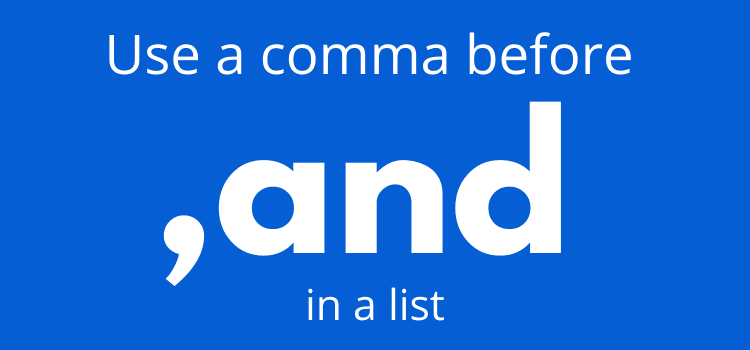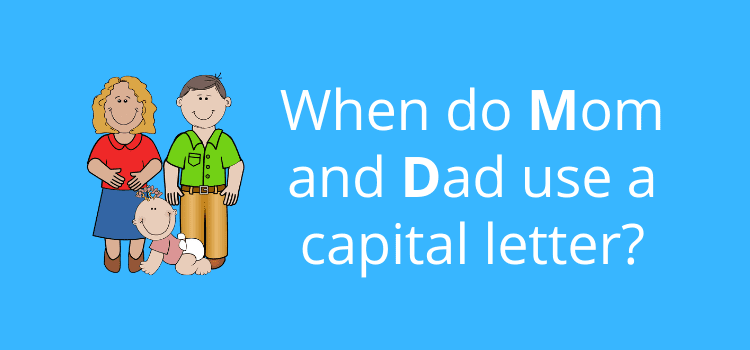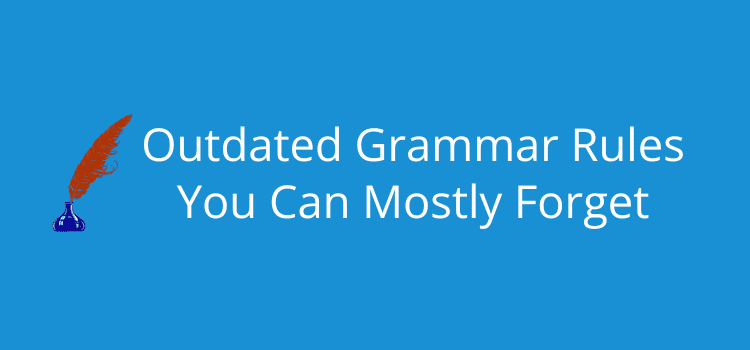
Should you add a comma before and in a list of three or more items? Yes, because it eliminates confusion in a sentence.
The comma before the word and in a list of three or more things is the Oxford comma. It’s also called the Serial comma.
Writers use it to separate the last item in a list to avoid uncertainty or misunderstandings.
One classic example that is often quoted is to my parents, Ayn Rand, and God. Without the comma, it could be misconstrued that the parents were God and Ayn Rand.
The clarifying comma
Style guides like the Associated Press Style Guide (AP Style), Cambridge University Style Guide, and The Chicago Manual of Style, among others, have differing opinions about the Oxford comma.
But when it comes to the comma before and in a list of three or more items, they generally agree.
Some say it’s optional when the last item is unclear.
While others say, it’s always necessary to avoid misunderstandings.
When it comes to legal writing, most guides insist on commas before and in a series to avoid any chance of ambiguity.
Of course, when there are only two items in a sentence with and, there is never a comma.
Here are two examples.
He went to the cinema with Jack and Sarah.
The flag is red and white.
It would be incorrect to add any punctuation in these phrases.
What’s the problem?
When you have a list of three items or more in a sentence, the last two items can seem to be linked together. This is what can cause confusion or create ambiguity. Let’s look at a simple sentence.
I had fried chicken, roast potatoes, green beans and ice cream for dinner.
Without a comma, it could be understood that green beans and ice cream were served together for dessert.
With a comma, it’s much clearer that the dessert was only ice cream.
I had fried chicken, roast potatoes, green beans, and ice cream for dinner.
Imagine you wrote about musicians.
My favorite musicians are the Beatles, the Rolling Stones and Simon and Garfunkel.
A reader might think that perhaps the Rolling Stones and Simon are together. With an added comma, there is no confusion.
My favorite musicians are the Beatles, the Rolling Stones, and Simon and Garfunkel.
To take a legal slant in a sentence.
Among the accused were a bank robber, arsonist, murderer and litterbug.
It could be read from this example that there were three accused because the murderer may also have been a litterbug. If that was not the case, a comma fixes the issue.
Among the accused were a bank robber, arsonist, murderer, and litterbug.
There are now clearly four accused in the list, and not three.
Do you have to use a comma before and in a list?
No. If your sentence makes sense and is clear, there is no rule that says you must put a comma.
It is especially true for sentences that use adjectives or qualities in a list.
My sister is smart, hard-working and kind-hearted.
My sister is smart, hard-working, and kind-hearted.
Both of the example sentences above are correct.
But in practice, adding a comma before the last element will always be clearer.
In other words, you can’t go wrong by using a comma. But you can go wrong without one.
If you want to be consistent, set your grammar checker to check this punctuation point.
When I set mine to US English, it always prompts me to add a comma before and for the last item in a list of three or more items.
Don’t confuse it with independent clauses
When you join one independent clause to another in one complete sentence with and, it is common to use a comma.
He spent two years studying in London, and so did my brother.
Yet, it is also correct to omit it.
He spent two years studying in London and so did my brother.
In both cases, each sentence is clear in meaning.
But if the second clause is dependent, you omit the comma.
He spent two years studying in London and my brother, too.
When there is no subject in the second clause, it is dependent on the first clause for meaning. Therefore, there is no comma to separate the dependent clause.
A comma after or before and
In most cases, you don’t use a comma after and.
But for sentences containing a parenthetical phrase (extra information), it is sometimes necessary to add a comma before and after and.
I usually take my dog for a walk near the lake on Sunday mornings, and, if the weather is warm, let him go for a swim.
Punctuation counts
There are many facets to writing, including grammar, spelling, and style. But you should never overlook correct and consistent punctuation.
The comma rules are open to interpretation in many instances. It’s up to you to decide on the rules you follow.
However, when it comes to the last item in a list, you won’t go wrong by always adding a comma before the last coordinating conjunction, which is and.
Yes, there are times when the meaning is clear, and you don’t really need to use it. But there are other situations when it is necessary.
To avoid any chance of confusion and to remain consistent in your writing, I would suggest you always add a comma when you list three or more items in a sentence.
Related reading: A Comma Before Because After A Negative Clause




Wonderful examples. I couldn’t agree more. Thanks for the post. I will be posting the link on my blog.